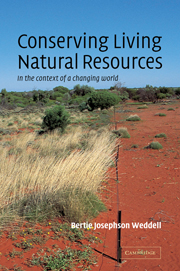Book contents
- Frontmatter
- Contents
- Preface
- Introduction: Balance and flux
- Methodology: Getting the information we need to manage living natural resources
- Part I Management to maximize production of featured species – a utilitarian approach to conservation
- Part II Protection and restoration of populations and habitats – a preservationist approach to conservation
- Part III Management to maintain processes and structures – a sustainable-ecosystem approach to conservation
- 11 Historical context – pressures to move beyond protection of species and reserves
- 12 Central concepts – the flux of nature
- 13 Techniques – conserving processes and contexts
- 14 Techniques – including people in the conservation process
- Postscript
- Appendix: Scientific names of organisms mentioned in the text
- Index
11 - Historical context – pressures to move beyond protection of species and reserves
Published online by Cambridge University Press: 05 June 2012
- Frontmatter
- Contents
- Preface
- Introduction: Balance and flux
- Methodology: Getting the information we need to manage living natural resources
- Part I Management to maximize production of featured species – a utilitarian approach to conservation
- Part II Protection and restoration of populations and habitats – a preservationist approach to conservation
- Part III Management to maintain processes and structures – a sustainable-ecosystem approach to conservation
- 11 Historical context – pressures to move beyond protection of species and reserves
- 12 Central concepts – the flux of nature
- 13 Techniques – conserving processes and contexts
- 14 Techniques – including people in the conservation process
- Postscript
- Appendix: Scientific names of organisms mentioned in the text
- Index
Summary
Scientists seeking to maintain biodiversity have made crucial contributions to conservation by developing strategies for protecting and restoring populations and ecosystems, but changing social, economic, and political conditions are presenting new challenges that are not fully addressed by these strategies. These are explored in this chapter.
So far, we have seen that wild organisms can be managed for utilitarian goals or for preservationist goals. These two threads have been woven through the conservation movements of the western world for nearly a century and a half. Recently, however, a third strand has appeared. This third approach strives to maintain ecosystem structure and function as a means of maintaining both biodiversity and productive capacity. Thus, its twin goals, management to produce goods and services and to maintain species and communities, encompass the goals of both utilitarian and preservationist management. (Of course, it may not be possible to do both in every situation.)
I call this approach to resource management the sustainable-ecosystem approach. Like “biodiversity,” the terms “ecosystem management” and “sustainable development” have both become popular buzzwords. “Ecosystem management” refers to a specific approach adopted by agencies managing federal lands in the U.S.A. (see below). I use the term “sustainable-ecosystem approach” not to refer to the program of any specific agency or organization, but to denote a type of resource management that seeks to conserve biodiversity and productivity by maintaining heterogeneous structures, components, and functions in interconnected ecosystems.
- Type
- Chapter
- Information
- Conserving Living Natural ResourcesIn the Context of a Changing World, pp. 279 - 300Publisher: Cambridge University PressPrint publication year: 2002



